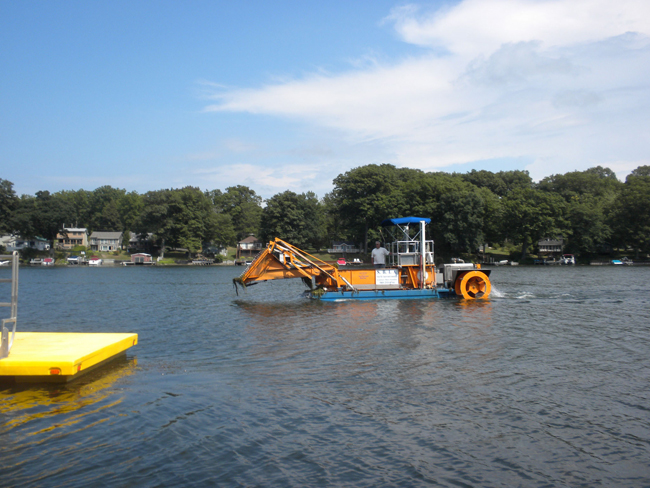By New York Sea Grant Launch Steward Clinton Whittaker
New York Sea Grant 2013 Launch Stewards Program
Contacts:
Mary Penney, NY Sea Grant, E:
mp357@cornell.edu, P:315-312-3042
Kara Lynn Dunn, Publicist, E:
karalynn@gisco.net, P: 315-465-7578
Oswego, NY, August 9, 2013 - Aquatic Invasive species (AIS) are non-native species that cause harm to the environment, the economy or human health. AIS are an increasing problem threatening ecosystems all over the United States. Locally, the eastern and southern shores of Lake Ontario and Oneida Lake are being affected by Eurasian water milfoil and European water chestnut. These AIS can reduce property values, harm ecosystems, reduce native habitats where young fish grow, and damage the overall quality of fishing by making entire areas impossible to fish.
Groups including local state and federal agencies, Partnerships for Regional Invasive Species Management (PRISM), and extension programs, including New York Sea Grant (NYSG), implement or educate the public about several methods to prevent or slow the spread of AIS.
Different types of AIS control include prevention, and physical, mechanical, chemical, and biological means.

The mechanical aquatic weed harvester operated by the Sodus Bay
Improvement Association.
Photo: Mary Penney/New York Sea Grant
Prevention involves outreach and education that aims to keep pristine
areas free of AIS and to contain AIS infestations to only the infested
waters.
With the goal of prevention in mind, the NYSG Launch Steward Program teaches boaters how to prevent the spread of AIS through voluntary watercraft inspections. The launch stewards are stationed at select boat launches located on Lake Ontario; Oneida Lake; the Oswego, Salmon and Little Salmon Rivers; and Sandy and Stony Creeks to offer voluntary education to boaters on how to look for, remove and properly dispose of unwanted aquatic hitchhiking debris, including AIS.
Through this outreach, the stewards are empowering the public to self-inspect watercraft, and by implementing watercraft inspection the boaters are helping to prevent the spread of AIS.
Physical control uses manpower to manage AIS. Hand pulls to remove water chestnut from infested waters are typically done by groups of people. On Oneida Lake water chestnut hand pulls have been co-organized by the Oneida Lake Rotary Club and New York Sea Grant, and the Finger Lakes PRISM with local Bass Masters.
The Oswego County Soil and Water Conservation District’s hand pull efforts on Oneida Lake are focused at Big and Muskrat Bays.
Those interested in organizing a local hand pull will find a how-to tutorial by NYSG Launch Steward Nick Spera online at
www.nyseagrant/ccd.
Mechanical control uses machinery to cut and remove AIS. The Wayne County Soil and Water Conservation District runs a mechanical harvester on Sodus Bay in an effort to control aquatic weeds. The aquatic harvester is used annually to control the water milfoil and curly leaf pondweed there.
Chemical control is an expensive, last-resort means of control that uses aquatic pesticides and requires appropriate training and certification. Chemical treatment to control water chestnut in the Oswego River has resulted in a smaller and less robust water chestnut population compared to years when the chemical control was not used.
Biological control introduces an invasive species’ natural predator into the aquatic environment. Years of controlled laboratory research are completed on biological control methods before a release is tested with diligent monitoring in a water environment. One concern with this method is that the biological control species, e.g., introduction of Pacific salmon to consume alewives in Lake Ontario, should not out-compete or prey on the local natural species.
Prior to the introduction of Pacific salmon in Lake Ontario, the alewife population experienced major die-offs in the summer months. As a result of the Lake Ontario Pacific salmon stocking program by the NYS Department of Environmental Conservation, the alewife population has been reduced to manageable numbers.
AIS impact us all. While it may be possible to contain, suppress, and, in some rare cases, eradicate AIS infestations, management takes considerable time and money. Because some control methods can be expensive and labor intensive, education methods, such as the NYSG Launch Steward Program, are important as cost-effective ways of engaging the public in helping to prevent and slow the spread of AIS.
For more information on protecting native habitats against invasive threats, contact New York Sea Grant at 315-312-3042,
SGOswego@cornell.edu. To learn more about the NYSG Launch Steward Program visit:
nysglaunchsteward.blogspot.com.
This is the third in a series of articles by the New York Sea Grant Launch Stewards. The stewards are college students helping to educate water users about how they can help slow the spread of aquatic invasive species as part of a statewide effort. Learn more online at
www.nyseagrant.org/ccd.
More Info:
New York Sea Grant (NYSG), a cooperative program of Cornell University
and the State University of New York, is one of 33 university-based
programs under the National Sea Grant College Program (NSGCP) of the
National Oceanic and Atmospheric Administration (NOAA). The NSGCP
engages this network of the nation’s top universities in conducting
scientific research, education, training and extension projects designed
to foster science-based decisions about the use and conservation of our
aquatic resources. Through its statewide network of integrated
services, NYSG has been promoting coastal vitality, environmental
sustainability, and citizen awareness about the State’s marine and Great
Lakes resources since 1971.
For updates on Sea Grant activities:
www.nyseagrant.org has RSS,
Facebook,
Twitter, and
YouTube links. NYSG also offers a free e-list sign up via
www.nyseagrant.org/coastlines for NY Coastlines, its flagship publication, and Currents, its e-newsletter supplement, each distributed several times a year.